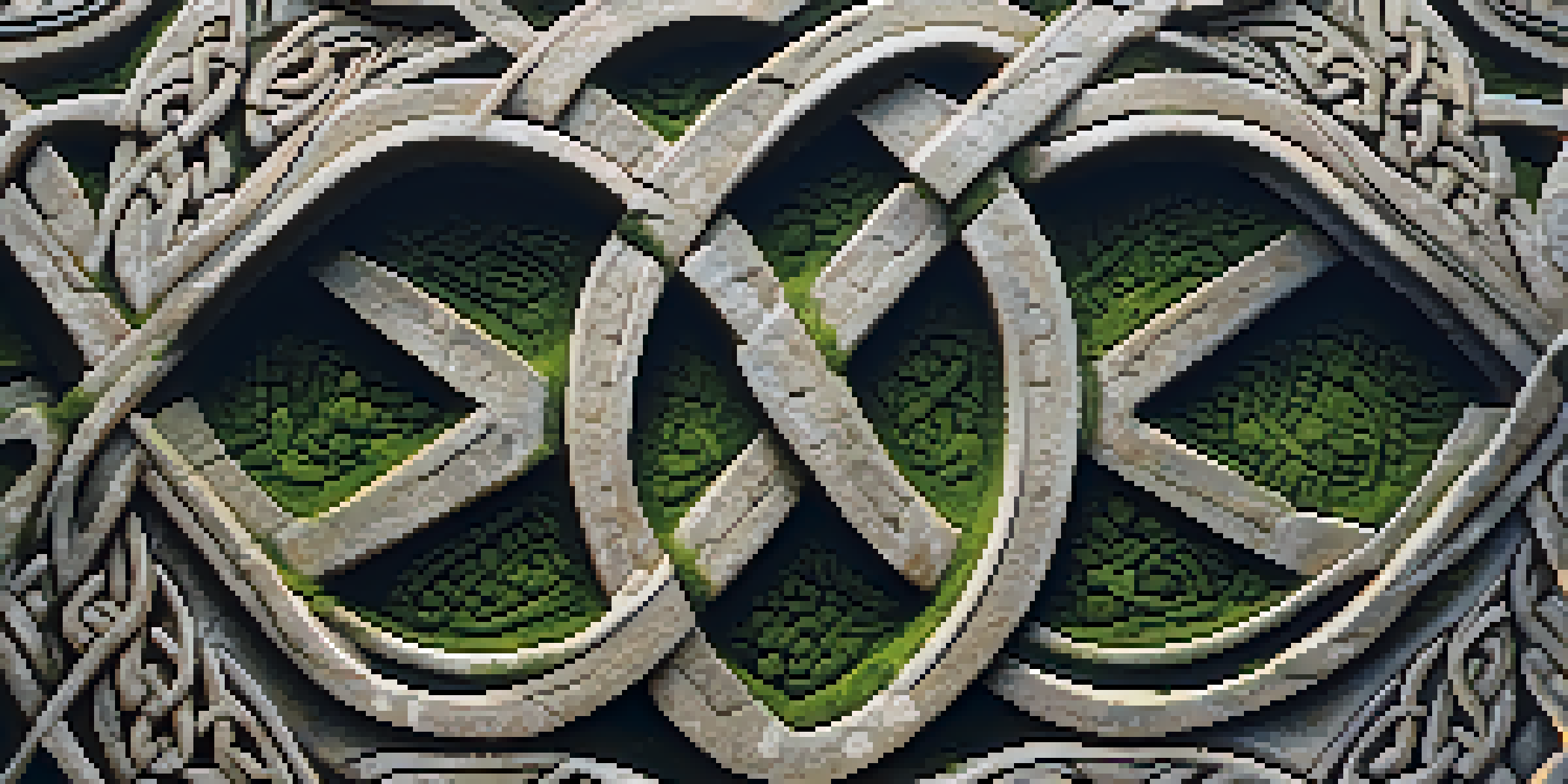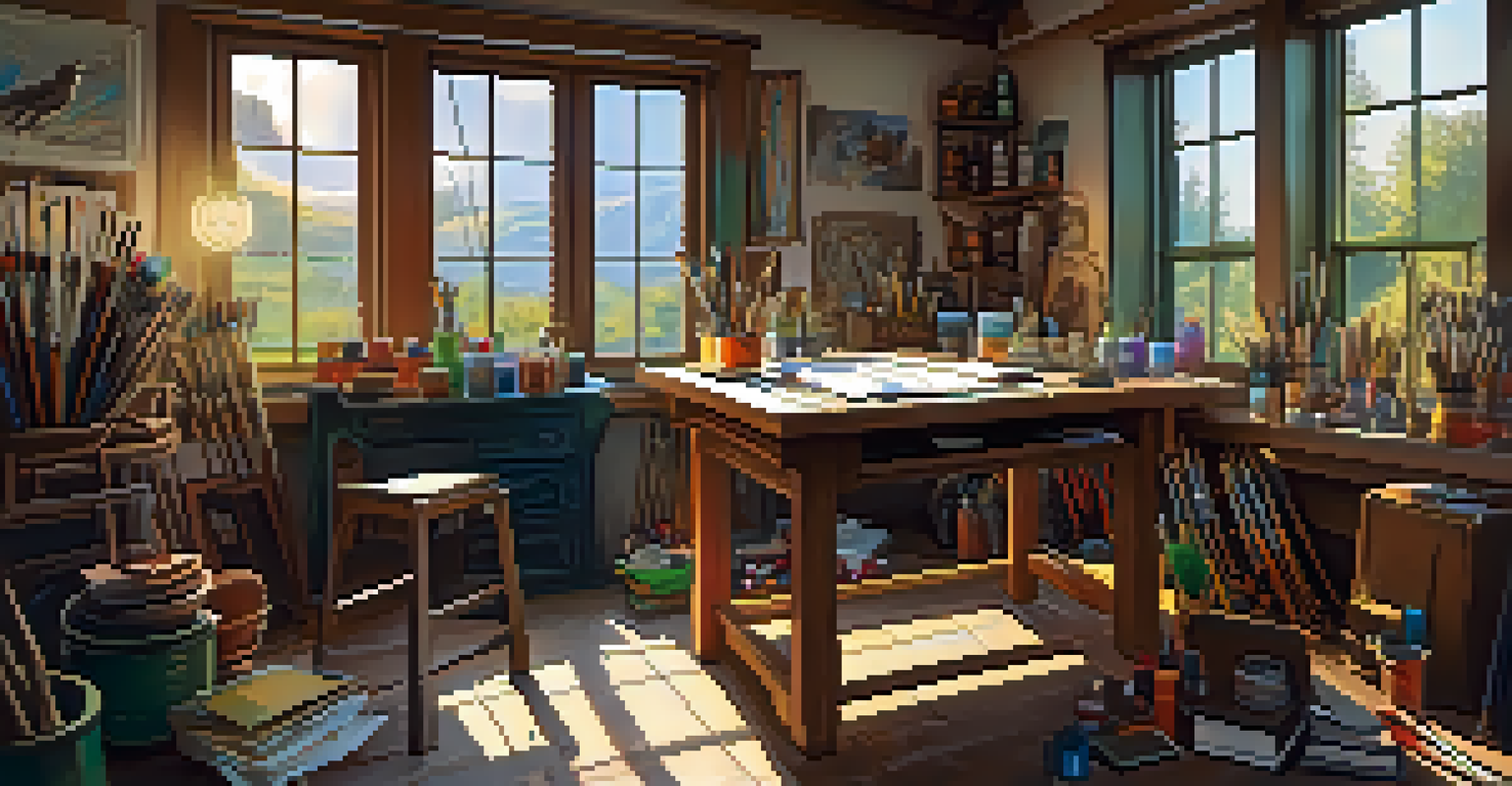Celtic Art: A Blend of History, Myth, and Culture

Understanding the Roots of Celtic Art and Culture
Celtic art traces its origins back to the early Iron Age in Europe, weaving together the stories and traditions of various tribes. These early artisans created intricate designs that reflected their beliefs and environment, showcasing a deep connection to nature. As the Celts spread across regions like Ireland, Scotland, and Wales, their art evolved, adapting local influences while maintaining its unique identity.
Celtic art is not just a form of expression; it is a reflection of the beliefs, values, and traditions of the Celtic people.
One of the most notable features of Celtic art is its distinctive use of patterns and motifs, such as spirals, knots, and animal forms. These designs are not merely decorative; they often carry symbolic meanings, representing concepts like eternity or the interconnectedness of life. This intricate artistry speaks to a culture rich in mythology and spirituality, where every piece tells a story.
In essence, Celtic art is more than just a visual experience; it’s a historical narrative. It serves as a window into the past, revealing how ancient societies viewed the world around them. As we explore Celtic art, we uncover the layers of history that have shaped it, making it a vital part of our cultural heritage.
The Influence of Mythology on Celtic Art
Mythology plays a crucial role in shaping the themes and symbols found in Celtic art. Legends of gods, heroes, and mythical creatures inspired artists to create works that captured the essence of these stories. For example, the famous figure of Cú Chulainn, a legendary warrior, often appears in various art forms, embodying bravery and strength.

These mythical narratives are not just tales; they represent the values and beliefs of the Celtic people. Artisans incorporated these themes into their work, using imagery to convey messages about honor, loyalty, and the supernatural. This blend of art and storytelling creates a unique experience, immersing viewers in a world where reality and myth intertwine.
Celtic Art Reflects Cultural Beliefs
Celtic art intricately weaves together mythology, spirituality, and nature, showcasing a unique connection to the Celts' values and worldview.
Furthermore, the use of mythological elements in Celtic art allows for a deeper appreciation of the culture’s spiritual beliefs. It highlights how the Celts viewed their relationship with the divine and the natural world. By studying these connections, we gain insights into the mindset of a civilization that celebrated life through art.
Celtic Patterns: More Than Just Decoration
Celtic patterns are renowned for their complexity and beauty, but they also serve a deeper purpose. The intricate designs, often featuring loops and interlacing lines, symbolize the continuity of life and the interconnectedness of all things. These patterns are not random; they reflect a worldview that sees existence as a cycle rather than a linear progression.
Art is the most beautiful of all lies, but Celtic art tells the most profound truths about life, nature, and our connection to the universe.
For instance, the endless knot is a common motif in Celtic art, representing eternity and the idea that life, death, and rebirth are intertwined. This symbolism resonates with many aspects of Celtic culture, emphasizing the importance of nature and the seasons. Through these patterns, artists convey profound messages about the human experience and our place in the universe.
Moreover, the revival of Celtic patterns in contemporary art demonstrates their lasting impact. Artists today continue to draw inspiration from these ancient designs, showcasing their relevance in modern contexts. This enduring appreciation for Celtic patterns highlights how art transcends time, connecting us to our ancestors and their beliefs.
Celtic Art in Manuscripts and Book Illumination
One of the most significant contributions of Celtic art is found in illuminated manuscripts, particularly during the early medieval period. These beautifully crafted texts, like the Book of Kells, showcase intricate illustrations and ornate lettering, bringing stories and religious texts to life. The meticulous attention to detail in these manuscripts reflects the dedication of the scribes and artists who created them.
Illuminated manuscripts were not merely functional; they were also expressions of faith and creativity. The vibrant colors and elaborate designs often depicted biblical scenes, saints, and Celtic symbols, merging spirituality with artistry. This fusion highlights the importance of storytelling in Celtic culture, as these texts served to educate and inspire communities.
Symbolism Deepens Artistic Meaning
The use of complex symbols in Celtic art, such as the triskele and endless knots, conveys profound messages about life cycles and the interconnectedness of existence.
Today, these manuscripts are treasured not only for their artistic value but also for their historical significance. They offer a glimpse into the beliefs, practices, and artistry of a time long past. By studying these works, we can better understand how the Celts viewed their world and the role of art in their everyday lives.
Celtic Symbolism: Decoding the Meanings Behind the Art
Celtic art is rich with symbolism, each piece often carrying multiple layers of meaning. From elaborate knots to animal representations, these symbols reflect the Celts' relationship with nature, spirituality, and community. For example, the triskele, or triple spiral, symbolizes life cycles, embodying concepts of birth, life, and death.
Understanding these symbols requires delving into the cultural context in which they were created. Many Celtic symbols relate to natural elements, such as the sun, moon, and earth, emphasizing the Celts' reverence for the environment. This connection to nature is a recurring theme in their art, reminding us of the importance of harmony between humanity and the natural world.
Moreover, the resurgence of interest in Celtic symbolism today highlights its relevance in modern spirituality and art. Many individuals resonate with these ancient symbols, finding personal meaning in their beauty and complexity. By exploring Celtic symbolism, we uncover timeless truths that continue to inspire and connect us across generations.
The Evolution of Celtic Art Through the Ages
Celtic art has undergone significant transformations throughout history, adapting to changing cultural landscapes. From its early beginnings to the influence of Christianity, each era brought new styles and techniques that enriched the Celtic artistic tradition. For instance, the introduction of metalwork and stone carving led to a surge in elaborate designs and intricate craftsmanship.
The arrival of Christianity marked a pivotal moment in Celtic art, merging pagan symbols with Christian themes. This fusion resulted in unique artworks that reflected the spiritual and cultural shifts of the time. Crosses adorned with Celtic motifs, like knots and spirals, became prominent, showcasing a blend of old and new beliefs.
Celtic Art's Ongoing Evolution
Throughout history, Celtic art has transformed by integrating new influences, ensuring its relevance and vibrancy in the modern world while honoring its ancient roots.
As we move into the modern era, Celtic art continues to evolve, inspired by both tradition and contemporary influences. Artists today draw from historical motifs while incorporating new mediums and styles, ensuring that Celtic art remains vibrant and relevant. This ongoing evolution highlights the dynamic nature of art and its ability to adapt while honoring its roots.
Preserving Celtic Art: Challenges and Innovations
In an age of rapid change, preserving Celtic art poses both challenges and opportunities. Many ancient artworks have suffered from neglect, environmental factors, and the passage of time. As a result, there is an increasing emphasis on conservation efforts, ensuring that these treasures are protected for future generations.
Innovations in technology have facilitated the preservation and study of Celtic art. Digital archiving, 3D scanning, and virtual exhibitions allow wider access to these artworks, making it easier for people to engage with this rich cultural heritage. These advancements not only preserve the art but also foster a deeper appreciation for its significance.

Community involvement plays a crucial role in preserving Celtic art. Local organizations and artists are working together to promote awareness and appreciation of this heritage, ensuring that the stories and traditions continue to thrive. By embracing both ancient practices and modern techniques, we can safeguard the legacy of Celtic art while inspiring future generations.